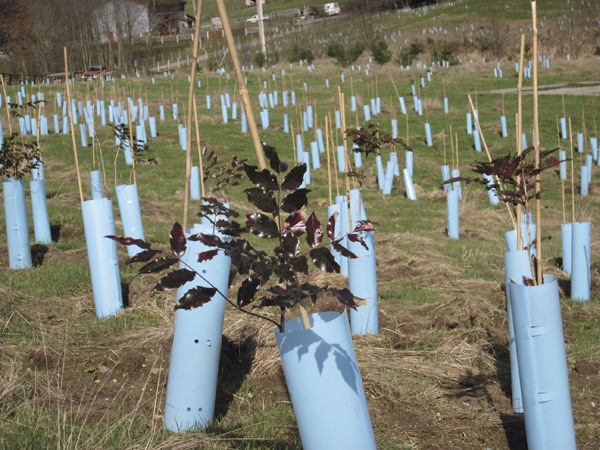“Why not thank people who are out there doing things on the ground?” That sentiment was expressed by a somewhat exasperated Jim Dam after spending a couple hours sitting in a Vashon-Maury Island Groundwater Protection Committee meeting.
In honor of World Water Day, March 22, I thought I would take Jim Dam’s advice.
Abel Eckhardt
I immediately thought of Abel Eckhardt, the Vashon Maury Island Land Trust’s land steward and an energizer bunny who can’t stop planting trees. A few days later, I ran into Gay Roselle at the Burton Post Office and found out she had just repaired her septic system, and I had heard rumors that Don Canfield and Linda Mather were revamping their expansive property on the west side to better accommodate seven horses.
I corralled Eckhardt at Singer’s Farm in Paradise Valley and was amazed by the changes to that landscape. The rolling pastures are dotted with newly planted trees and shrubs. The plants are surrounded by blue plastic tubes to thwart voles from treating the seedlings as hors d’oeuvres. It looks quirky. I can’t help but imagine a banner announcing “Blue Tube Farms: A Christo Installation Curated by Abel Eckhardt.”
The land trust bought the 15.2 acre parcel east of Singer Road from the five Singer siblings in 2007, planted and fenced three acres of Judd Creek buffer and leased 12 acres of pasture back to George and Marilyn Singer to run horses and cattle. Two years ago, King County bought a conservation easement on the parcel, which precludes livestock use. The horses and cows were pulled off last November.
George and Marilyn Singer still own the 18.4 acre parcel on the west side of Singer Road. George would prefer to continue to lease the land trust’s acreage so he can rotate his livestock over more pasture, but the land is instead being restored back to forest. Eckhardt will plant low-growing vegetation to preserve the Singers’ view corridor of Mount Rainier in exchange for being allowed to revegetate and fence off the creek and springs on the Singers’ property.
While I chatted with Eckhardt, a neighbor pulled up on his bike and conferred with him about hosting a work party on the land trust property for an upcoming birthday. What a great way to honor yourself, the land and the future. Gather your friends and, with Eckhardt’s guidance, help recreate a forest on land protected into perpetuity. Now that’s a legacy.
Gay Roselle
Gay Roselle’s property, a rental, is not waterfront; rather it is upland on the outer edges of the Judd Creek watershed. I was curious to find out why her septic system failed, how she fixed it and how much it cost. Renters notified her that the backyard was getting smelly. Several factors lead to the demise of her system. First, a huge cottonwood tree was smack-dab in the middle of her drainfield. Its roots had grown inside the infiltration pipes blocking over a half of the drainfield. Secondly, she thought only four people were living in the house, but there were actually eight, so the system was compromised by overuse. Finally, the sand filter may have been installed improperly.
Roselle, a science teacher at McMurray Middle School, now has a brand new “whitewater system” — a relatively new type of aerobic treatment unit. Bacteria are more efficient at consuming sewage when oxygen is available, so air is pumped through the sewage. After small particles settle out the liquid portion is exposed to ultraviolet light to kill bacteria before it is pumped to the drain field. Roselle says the whole project cost her about $12,500. That’s a lot of money, but actually cheaper than I expected. My conventional system cost about $10,000 when we built our house 18 years ago.
Don Canfield and Linda Mather
Don Canfield and Linda Mather have a new farm plan for their 13.5 acres straddling the uplands of both Green Valley and Fisher Creek watersheds. Fisher Creek flows into Quartermaster Harbor southwest of Burton, while Green Valley Creek heads west to Colvos Passage. They have installed French drains around the barn and loafing sheds and between paddocks to minimize mud and redirect rainwater so it doesn’t flow through areas where it can pick up animal waste. They’ve put in new cross-fencing and plan to build a new concrete-floored manure bin they can cover in winter. A small wetland, the headwaters of Fisher Creek, will be enhanced with new buffer plantings.
Canfield, a veterinarian, gives a lot of credit to King Conservation District (KCD) staff who provided invaluable technical assistance as well as financial incentives. The KCD will pay up to 50 percent of the cross-fencing cost, and King County will provide up to $5,000 for manure management and water diversion elements. Canfield said he knows both water and manure head downhill and he wanted to take care of it, but without the KCD’s help, change would have taken a lot longer.
All three projects affect watersheds that flow to Quartermaster Harbor. Without these types of upland efforts, we cannot hope to improve the low-oxygen conditions in the harbor. An analysis of the bay, called the Quartermaster Harbor Nutrient Loading Study, estimates that 63 percent of the external nitrogen input to the harbor comes from streams, while only 17 percent comes from nearshore septic systems. Both the land trust project and the Canfield/Mather project have benefitted from public funding. Some would object to our tax dollars being spent this way, in particular on private property, but I see how much time, effort and backbreaking work our dollars have leveraged from private citizens. It is work that is helping restore the land and, in my opinion, money well spent.
— Susie Kalhorn is an environmental educator and writer on Vashon.



